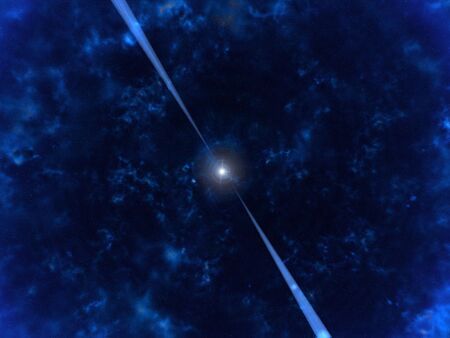Pulsar

Pulsars are highly magnetized, rotating neutron stars that emit a beam of electromagnetic radiation. The observed periods of their pulses range from 1.4 milliseconds to 8.5 seconds. The radiation can only be observed when the beam of emission is pointing towards the Earth. This is called the lighthouse effect and gives rise to the pulsed nature that gives pulsars their name. Because neutron stars are very dense objects, the rotation period and thus the interval between observed pulses is very regular. For some pulsars, the regularity of pulsation is as precise as an atomic clock. A few pulsars are known to have planets orbiting them, as in the case of PSR B1257+12. Werner Becker of the Max Planck Institute for Extraterrestrial Physics said in 2006, "The theory of how pulsars emit their radiation is still in its infancy, even after nearly forty years of work."
The events leading to the formation of a pulsar begin when the core of a massive star is compressed during a supernova, which collapses into a neutron star. The neutron star retains most of its angular momentum, and since it has only a tiny fraction of its parent's radius (and therefore its moment of inertia is sharply reduced), it is formed with very high rotation speed. The general agreement is that a pulse from the neutron star is the result of a beam of radiation pointing in the direction of Earth; once for every rotation of the Neutron Star. The beam originates from the rotational energy of the neutron star, which generates an electrical field from the movement of the very strong magnetic field, resulting in the acceleration of protons and electrons on the star surface and the creation of an electromagnetic beam emanating from the poles of the magnetic field . The beam appears as a pulse due to the misalignment of the rotation axis and the axis of the magnetic field of the star. This rotation slows down over time as electromagnetic power is emitted. When a pulsar's spin period slows down sufficiently, the radio pulsar mechanism is believed to turn off (the so-called "death line"). As this seems to take place after ~10-100 million years, but neutron stars have been formed throughout the ~13.6 billion year age of the universe, more than 99% of neutron stars are thought to no longer be pulsars.
The first pulsar was observed on November 28, 1967 by Jocelyn Bell Burnell and Antony Hewish. Initially baffled as to the seemingly unnatural regularity of its emissions, they dubbed their discovery LGM-1, for "little green men" (a name for intelligent beings of extraterrestrial origin). While the hypothesis that pulsars were beacons from extraterrestrial civilizations was never taken very seriously, some discussed the far-reaching implications if it turned out to be true. Their pulsar was later dubbed CP 1919, and is now known by a number of designators including PSR 1919+21, PSR B1919+21 and PSR J1921+2153. Although CP 1919 emits in radio wavelengths, pulsars have, subsequently, been found to emit in visible light, X-Rays, and/or Gamma Rays wavelengths.
The word "pulsar" is a contraction of "pulsating star", and first appeared in print in 1968.